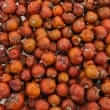Background
- Black bryony (Tamus communis) is a flowering, herbaceous vine in the yam family (Dioscoreaceae) that grows 2-4 meters tall and bears bright red berry fruit. Native to Europe, northwestern Africa, and western Asia, black bryony has twining stems and spirally arranged heart-shaped leaves that grow up to 10 centimeters long and 8 centimeters wide. The greenish-yellow flowers grow to be 3-6 millimeters in diameter, with six petals per bloom. The male flowers produce then 5-10 centimeters racemes; female flowers are arranged in shorter clusters.
- There is currently insufficient available evidence in humans to support the use of black bryony for any indication.
- Black bryony (Tamus communis) is not currently listed on the U.S. Food and Drug Administration (FDA) "Everything Added to Food in the United States" (EAFUS) database, and its generally regarded as safe (GRAS) status is currently not available.
- According to secondary sources, all components of the black bryony plant, including the tubers, are poisonous due to saponin content. Therefore, it is not typically used internally; however, it has been used as a poultice for bruises and inflamed joints. It has been suggested that black bryony be used topically with caution, due to a tendency for the plant to cause painful blisters.
- Studies have isolated calcium oxalate deposits and histamines in the berry juice and rhizomes, which may contribute to skin irritation and contact dermatitis associated with black bryony.
References
Natural Standard developed the above evidence-based information based on a thorough systematic review of the available scientific articles. For comprehensive information about alternative and complementary therapies on the professional level, go to . Selected references are listed below.
- Capasso, F, Mascolo, N, Autore, G, et al. Anti-inflammatory and analgesic activity in alcoholic extract of Tamus communis L. J Ethnopharmacol 1983;8(3):321-325.
View Abstract - Kovacs, A, Forgo, P, Zupko, I, et al. Phenanthrenes and a dihydrophenanthrene from Tamus communis and their cytotoxic activity. Phytochemistry 2007;68(5):687-691.
View Abstract - Rethy, B, Kovacs, A, Zupko, I, et al. Cytotoxic phenanthrenes from the rhizomes of Tamus communis. Planta Med 2006;72(8):767-770.
View Abstract - Mascolo, N, Autore, G, and Capasso, F. Local anti-inflammatory activity of Tamus communis. J Ethnopharmacol 1987;19(1):81-84.
View Abstract - Aquino, R, Conti, C, De Simone, F, et al. Antiviral activity of constituents of Tamus communis. J Chemother 1991;3(5):305-309.
View Abstract - Schmidt, RJ and Moult, SP. The dermatitic properties of black bryony (Tamus communis L.). Contact Dermatitis 1983;9(5):390-396.
View Abstract - Kashchenko, VB. and Kozhukhar', GS. [Toxidermia caused by Tamus communis]. Vestn Dermatol Venerol 1986;(5):50-51.
View Abstract - Miliavskii, AI. [Contact dermatitis caused by black bryony]. Vestn Dermatol Venerol 1979;(7):49-50.
View Abstract - Capasso, F, De Simone, F, and Senatore, F. Sterol constituents of Tamus communis L. J Ethnopharmacol 1983;8(3):327-329.
View Abstract







